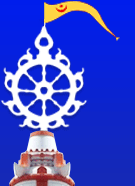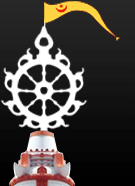LIVING TRADITION >> Nabakalebara
Nabakalebara is a unique feature of Shree Jagannatha Temple tradition which occurs once at intervals of 8, 11, 12 and 19 years, ‘Nabakalebara’ means new embodiment; the periodical. It involves in the total replacement of the five worshipped wooden idols. The reason for replacement of images in every 12 or 19 years is traced to some astronomical and astrological considerations. Usually when two Asadha months fall and as per the temple tradition, when a leap month falls in the month of Asadha, it becomes convenient to perform the Nabakalebara ceremony. The extra Asadha month is known as ‘Purusottam Masa’ or ‘Adhimasa’ where as the common people terms it ‘Malamasa’. This tradition is based on some practical considerations. Because of the leap month or extra Asadha month, more time (3 fortnights) is available for the construction of the new images, their consecration and covering of patta cloth as well as painting, before the temple re-opens on the occasion of the Ratha Yatra.
The process of Nabakalebara comprises 12 steps. These are as such (1) Vanajaga Yatra (2) identification of the divine trees (3) construction of sabarapalli (4) Traditional Vedic rituals and sacred fire sacrifice (5) cutting and shaping of divine tree (6) journey of the divine log to Shreekshetra (Puri) (7) construction of karusala, Nyasa Mandapa, Adhibasa Mandapa, log room etc. (8) construction of new idols (9) Brahmostav leela (10) Golakh leela (11) Burial of old deities (patali) (12) completion of wooden images (saptavarana) and Navajaubana (appearance of new deities before devotees)
As per tradition, Nabakalebara rituals are of two types. One is keeping the idols intact. No physical change in the wooden image is given effect to Minor repair, if necessary, of the idol is taken up and ‘Saptabarana’ of the old deities is performed. Which is known as “Sriangaphita” The other type is collection of divine log, construction of idols, fire sacrifice, and change of life substance, performing secret rituals and bringing the wooden images into final shape.
The first step of Nabakalebara is Banjara Yatra held on the 10th day of Chaitra Sukla Pakshya dasami (10th day of lunar fortnight of chaitra). Banajaga Yatra consists of several groups of servitors such as Daita, Pati Mohapatra, Biswakarma, Deulakarana, Tadhaukarana, Srotriya Brahmins etc.
The identification of four holy Neem trees is done on the basis of certain specifications (Daru characteristics). Although the Badagrahi Daitapati, Bidyapati, Biswabasu, Deulakaran, Tadhaukaran, Lenka, Biswakarma play significant role in the different processes of Bahirbanajaga, the srotriya Brahamins, Acharya, Rajguru and Deulapurohit also play equally important roles near the holy tree. They conduct secret rituals, pujas and perform sacred fire etc.
As per tradition the holy log of Lord Shree Sudarshana, Lord Shree Balabhadra, Devi Subhadra and Lord Shree Jagannatha are transported serially to Koili Baikuntha through the northern gate of Shree Jagannatha Temple.
Construction of wooden images of the deities at Koili Baikuntha commences after Snana Yatra (Jestha Purnima). Biswakarma Maharana servitors are engaged for the construction of five wooden images under the close guidance of Daitapatis. The work is done secretly. Construction of ‘Nyasadaru’, worship of Nrusingha, fire sacrifice and vedic rituals etc. are done simultaneously along with the carving of idols.
After completion of sacred fire and consecration of Nyasadaru, the newly carved out deities are placed on the Nirman Mandapa under the guidance of Badagrahi Daita and Pati Mahapatra.
On the 14th day of dark fortnight of the month of Asadha in late night hours the life substance (Brahma Padartha) from the old idols are removed and transferred to the new idols. The old deities are buried at a particular place in the Koili Baikuntha. This is known as ‘Patali’. Thereafter Saptabarana rituals of the new idols are performed confidentially by the Daita and Pati Mahapatra.
Nabakalebara of Shree Jagannatha Mahaprabhu involves vast and complex process. Nowhere in the world is this type of sporting spree of deities seen. Nabakalebara Rath Yatra is one of the country’s most incredible spectacles as well as one of the most popular festivities.





